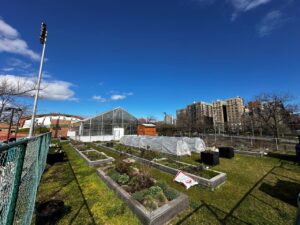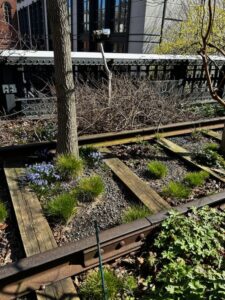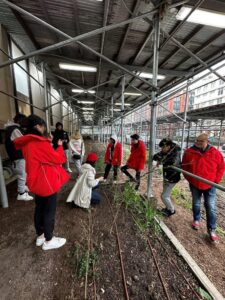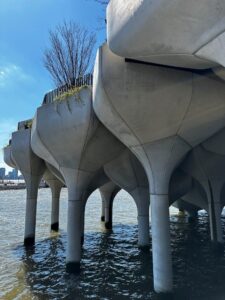
The educational value of urban green spaces for students
By Michael Casey
In the heart of bustling cities like New York, amidst the concrete jungle, lies an oasis of greenery and tranquility. These green spaces, often overlooked amongst the skyscrapers and busy streets, play a vital role in enhancing the quality of urban life and fostering a deeper connection with nature.
My journey into the world of green spaces began with a passion for transforming urban environments. From incorporating green infrastructure into hospital settings to introducing greenery into school campuses, every opportunity to add a touch of nature has brought me immense satisfaction. Witnessing the positive effects of green spaces on people’s lives has reinforced my belief in the importance of this work and encouraged me to do more.
Recently, I had the opportunity to embark on a tour of New York City with a group of Australian year 11 and 12 VCE (Victorian Certificate of Education) students all eager to learn about urban green spaces. New York, with its dense population and limited space, presents a unique challenge in creating and maintaining green areas. However, the city boasts remarkable examples of innovative green spaces that serve as inspiration for urban planners and enthusiasts alike, and this setting was to be the backdrop for our nine days of touring.

Our tour began with visits to iconic green spaces like the High Line and Little Island. These reclaimed urban areas not only provide a respite from the city’s hustle and bustle but also serve as hubs for community engagement and cultural enrichment. As we strolled along the elevated walkway of the High Line, surrounded by lush vegetation and stunning city views, the students’ appreciation for the symbiotic relationship between nature and urban life became evident.
Each stop on our tour provided valuable insights tailored to the students’ diverse interests and areas of study. Business studies students learned about the economic impact of green infrastructure projects and witnessed first-hand the new economy building around the thousands of tourists using this space. Arts and performance students explored the intersection of art, architecture, and nature within these spaces, even noting the many houses overlooking the High Line that boasted beautiful art pieces in their own gardens.
Food tech and horticulture students discovered the potential for urban farming and urban greening to address food insecurity and promote community resilience, along with acknowledging that the use of trees helps alleviate urban heat and provides a tranquil and cool space against the sometimes hot and glary backdrop of the built environment.
The many discussions sparked between each group during these visits underscored the multifaceted benefits of green spaces beyond mere aesthetics.
One of the highlights of our tour was the exploration of urban farms nestled within the cityscape. These urban agricultural projects, such as the NYU (New York University) training and education garden in New York city, along with the industry and community-run initiatives and programs in Harlem, serve as vibrant examples of the transformative power of green spaces. The NYU training garden, better known as the Urban Food Lab, is located prominently at the front of the university and not only serves as a source of fresh produce for community, but also functions as a vital educational resource for students and local communities.

Here, students along with individuals from the community have the opportunity to learn about sustainable farming practices, environmental stewardship, and the importance of urban agriculture in addressing food insecurity.
Similarly, the community-run initiatives in Harlem, run by The Horticultural Society of New York, represent grassroots efforts to utilise vacant lots and under-utilised spaces for the cultivation of food and the promotion of community well-being.
Their urban farm located at Denny Farrell Riverbank State Park, not only provides nutritious food options for local residents but also serves as gathering places for neighbours to come together, share resources, and strengthen social bonds. Moreover, by empowering individuals to take ownership of their food production, these urban farms contribute to greater food sovereignty and resilience within the community. One thing that really impressed me was that this farm, along with parks, open spaces and a full athletic running track were all located on the roof space of the sewage treatment facility operated by the New York city. This 28-acre community space is a welcome addition to the Harlem precinct.
These spaces furthered our discussions around the economic implications of urban farming. In addition to providing employment opportunities and skill-building experiences for local residents, urban agricultural projects contribute to the revitalisation of neighbourhoods and the creation of vibrant, sustainable economies.
Through initiatives like farmers’ markets and community-supported agriculture programs, these projects not only generate income for farmers but also stimulate local businesses and attract visitors from surrounding areas, thereby fostering economic growth and prosperity.
Our exploration of urban farms underscored the multifaceted benefits of these green spaces, from promoting food security and community engagement to driving economic development and environmental sustainability. By harnessing the power of community engagement and empowerment, urban agricultural projects have the potential to transform cities into thriving, resilient communities where people and nature co-exist harmoniously.

Throughout our journey, I continued to observe a profound shift in the students’ perceptions of green spaces and their impact on well-being. Engaging in outdoor activities like the bicycle tour of Central Park, despite adverse weather conditions, highlighted the therapeutic effects of nature on mental health and cognitive function. As they reflected on their experiences, it became evident that green spaces had become essential elements in their daily lives while on this trip, providing solace and rejuvenation amidst the urban chaos of New York. The comments though, which I feared would be negative, were only of enjoyment and accomplishment; a joy that they had accomplished such a physical activity albeit wet, cold and tired. And to top this off, they commented on how great it felt to be outdoors and not in front of a television or on their phone as they all stated they would have been had they stayed back at the hotel. Leaving Central Park after the ride, the comments continued; this time about how quiet and calming the park was, which they only realised once they exited it and ventured back into the noises of the city.
In a world increasingly dominated by concrete and technology, the importance of green spaces cannot be overstated. They serve as essential sanctuaries for both physical and mental well-being, fostering a sense of connection with the natural world. As urbanisation continues to reshape our cities, it is imperative that we prioritise the creation and preservation of green spaces for the benefit of current and future generations. By embracing greenery in our urban environments, we not only enhance the aesthetic appeal of our cities but also enrich the lives of those who inhabit them. Let us continue to nurture and cherish these green oases amidst the urban landscape, for they are the lifeblood of our cities and the soul of our communities. Experiencing this trip with students eager to learn more about the built environment added to the richness of the experience, highlighting the importance of education and engagement in shaping sustainable urban futures.
Michael Casey
Director of Evergreen Infrastructure
Consultant and advisor to the green infrastructure industry
Technical Panel for the AIPH World Green Cities Awards 2024
E: michael@evergreeninfrastructure.com.au
